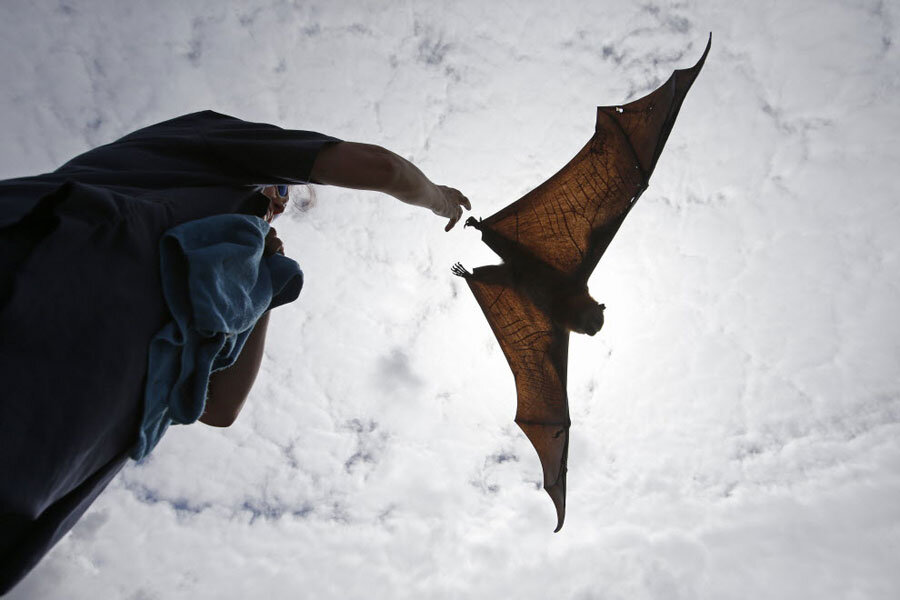How many species will climate change push to extinction? Study offers clue.
Loading...
Global warming could drive up to 16 percent of the planet's species to extinction, according to a new study, which aims to provide a worldwide look at the impact of climate change on biodiversity.
If the increases in greenhouse gas emissions from burning fossil fuel and from land-use changes continue unabated, humanity could in effect sign the extinction warrants by the end of the century.
These loses would come on top of losses driven by other factors.
For instance, ecologists expect 15 to 30 percent of the planet's species to go extinct as changes in human land-use patterns chop up or destroy habitat.
The state of the planet's biodiversity has economic implications for rich and poor countries alike, as well as cultural and ethical dimensions.
At least as far back as 1996, when paleoanthropologist Richard Leakey published a book on the topic, researchers have spoken in terms of humans as the main triggers for a sixth great extinction in history, threatening the diversity of life on Earth.
It took some 10 million years for Earth to recover the biodiversity it lost in the previous mass extinction 65 million years ago, says Stuart Pimm, a conservation ecologist at Duke University who did not take part in the study.
"We're not going to go extinct" in the face of climate change and its added impact on biodiversity, he notes. But major changes in biodiversity can alter the quality of that survival.
"The question is: What kind of life will we have?” he says, adding that biodiversity enriches life ethically, aesthetically, and economically.
Yet today, "we're in a triage state," says Mark Urban, an ecologist at the University of Connecticut at Storrs, who performed the new analysis, set to appear in Friday's issue of the journal Science.
Climate isn't the only pressing extinction threat, he notes, but "the climate risks are starting to rise. We have to start to decide where we're going to place our resources" to help maintain as much biodiversity as possible as global warming joins the other factors threatening biodiversity.
Previous studies have looked at the potential impact of climate change on species on smaller scales. Dr. Urban drew on 131 of them to capture the threat globally. The number of species in a given study ranged from 2 to more than 24,000.
On a regional basis, South America faces the highest risk of species loss to warming, followed by Australia and New Zealand. Taken together, they could lose 14 to 23 percent of their species.
These areas are the most vulnerable because they host large numbers of species unique to specific areas and adapted to unique local climates that would disappear with global warming.
By contrast, North America and the region that encompasses Europe and western Russia eventually could lose 5 to 6 percent of their species to warming this century.
Africa and Eurasia south of the Black and Caspian Seas and east of the Ural Mountains fall somewhere in the middle of the extinction-risk spectrum.
As temperatures rise, so does the proportion of species at risk, Urban found. The temperature increase from preindustrial levels to today, about 0.8 degrees C, has put an additional 2.8 percent of the planet's species at risk. At 2 degrees C – a level at which countries are trying to stabilize the rise in global average temperatures by the end of the century – some 5 percent of species would likely head for extinction. That proportion rises to 16 percent if emissions follow a business-as-usual path.
But Urban cautions that the studies on which he based his analysis omit important factors – basically for lack of data – that could increase or decrease risks of extinction. Evolution, for instance, could allow some organisms to adapt to a warmer climate while additional habitat destruction or fragmentation could hasten extinction in some species.
For example, a study published in the journal PLOS One found that perhaps food or physique had kept alpine birds at lower, warmer altitudes than models would have predicted. Fifty-five bird species in Peru moved up the slope of the Andes to cooler temperatures – but not as far up as would have been expected for the birds to remain within their preferred temperature limits.
Whatever the explanation, the work points to a need for similar studies to help make model projections of extinctions more accurate, says Dr. Pimm, who was one of the authors of the study in PLOS One.
In identifying such gaps in the studies he used, Urban's analysis has value beyond quantifying extinction risks, Pimm says.
The analysis "is very, very useful paper in terms of summarizing what people know and think and in identifying the way forward" to improve the estimates, he says.
Even so, more work needs to be done even if one looks only at climate, he adds. The new study doesn't account for the impact on habitat of more frequent extremes of heat, cold, drought, or rain and snowfall. These also can significantly alter habitats.
The global results dovetails with what Pimm says is a limited but growing number of studies that show species are moving in response to human-triggered climate change.
That, combined with the consistency in migration estimates models provide "tell us that we need to be very energetic in our conservation actions," he says.






